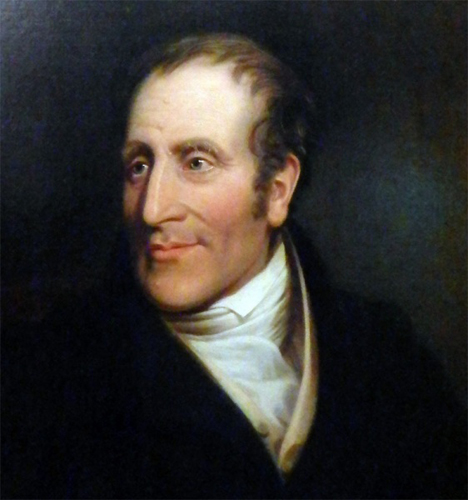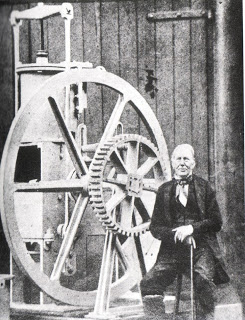In 1812 the first commercially viable paddle steamship in Europe set off along the Clyde. It was the brainchild of Henry Bell. He wanted to be able to ferry customers from Port Glasgow to his Bath Hotel in Helensburgh. It was called the Comet (because of Halley’s Comet which appeared in the sky while she was being built) and it looked exactly like this:

Before his steamboat arrived, the only direct method of travelling to the hotel was by row boat with a sail when the wind was right. Rowing, it took three to four hours depending on the tide. PS Comet could only manage about five miles an hour but at least it was easier on the arms.
It did, however, do the rowers out of a job, something they’d probably been doing all their lives. This was a big concern in London when the first steamships started to appear. To be fair, it was also a concern when bridges started spanning the Thames with the guys who’d take you across for a penny realised that walking was cheaper…though that has nothing to do with this entry…
In order for Henry to build his new steamship he had to employ a few people. For the boat itself, he chose John Wood and Co, one of the biggest shipbuilders on the Clyde at the time. For the boiler he went to Napier’s who were equally well known and respected. For the new engine, however, he went to the little known engineer John Robertson.
John Robertson was an inventive chap. He was born on December 10, 1782, the son of an engineer who had managed to upset the men he worked with by inventing labour saving devices which saw a lot of them replaced. It seems his inventiveness was passed down to his son along with a small engineering shop in Glasgow. It was to here that Bell came in 1808 to discuss commissioning a steam powered pump.
That was their first meeting but by no means their last. So impressed by his engineering skills, Bell asked Robertson to build the engine for the Comet.
So everyone cracked on and, finally, the Comet was ready for her test run. She passed beautifully and was soon put into service. She must have been an amazing sight along the banks of the Clyde as she putted up and down, delivering passengers then bringing them back full of healthy spring water.
And the rest, as they say, is history except for the small matter of payment. Bell didn’t pay Robertson. Bell also didn’t pay Wood. I have no idea if Bell paid for the boiler but it was probably the case that Robertson paid Napiers then never had anything back from Bell.
When I realised this I was pretty mad at Henry Bell. I mean what a bastard! It didn’t really bother Woods and Napiers but poor old Robertson eventually went broke because his outgoings far outweighed his incomings. The poor chap died a pauper on November 19, 1868 with little recognition apart from the great Napiers who remained faithful friends until the end of his life.
Wonderfully, at the age of 81 he caught the train down to London, to the Science Museum (which was the Patent Museum at the time) in order to put together his famous engine which had been given to the museum by Napiers. Here’s a photo of him with his engine just before leaving Scotland for London.
But, it happens that I was completely wrong. Poor Henry Bell was just as bad as a lot of the great inventors – he had a brilliant mind for creating wonderfully innovative designs but his business sense left an awful lot to be desired. In fact, he was useless. He didn’t bother patenting anything so his ideas were stolen left right and centre and very soon the Clyde was full of paddle steamers and he didn’t benefit a jot.
Fortunately for Henry, his wife was superb at managing hotels and so they survived on her wages and skills, running the Bath Hotel in Helensburgh. Henry eventually gave up inventing steamships. It didn’t take long for other engineers and ship designers to improve on his design. Very soon there were faster, bigger and brighter ships to take passengers from Port Glasgow to Henry’s hotel. The Bell’s retired quietly and, I assume, happily. I mean he looks happy in the photo:

Anyway, that’s the story, really. There’s just one more thing to add. The technical file for the object I was researching (Robertson’s engine) contains a lovely series of 1863 letters to and from the museum regarding the engine. Here’s just one of them.

What a wonderful find.




Yes what a wonderful find and a great story of cause we learnt about him at school but always nice to hear it again as I have forgotten a lot
Love mum xx
Hi
I stumbled on your article.
I had googled ‘Robertson – was he paid?’
I am a descendent of Robertson I believe – and my grandfather who had a sense of humour claimed payment from Ithgows Shipyard sometime in the 1950s or 60’s.
So I guess he was a direct relation and this was a family story handed down
Hi was interested in knowing about John Robertson my mum passed away last year and I found a article about john Robertson in with her paperwork her dad was also named John Robertson and there was a lot of things that related to my mums family there’s nobody that I can ask but was curious why my mum had this article
Hi Georgina
I can’t say why your mum might have had the article about John Robertson unless it was in connection with her father? Or his name?
John Robertson (1782-1868) married a Margaret Stewart on 4 December 1804. They had four children, Janet (1825), Thomas (1828), Jean (1830) and James (1834). Jean married a William Lands, and they had at least one child, John (c 1849). I don’t know about the other three children but one may be a direct ancestor of your mother.
There’s a nice piece regarding a dedication to him on the FindAGrave website here: https://www.findagrave.com/memorial/186846805/john-robertson
Hope that helps a bit.
Regards
Gary